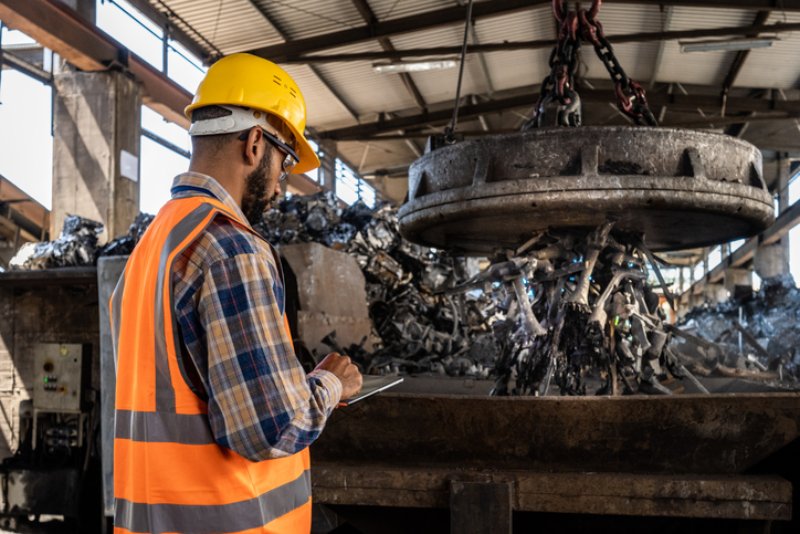5901 Botham Jean Blvd, Dallas, TX 75215
Managing Scrap Yard Hazards for Safer Operations
June 16, 2025At first glance, scrap yards look like a chaotic sprawl of metal and machines, but there’s a lot more to it than meets the eye, especially when it comes to safety. Between heavy equipment, sharp scrap, and unpredictable materials, such an environment demands serious attention to risk management. This starts with a solid scrap yard risk assessment, ongoing safety training, and a team that knows what to look for. Learn basic scrap yard safety tips and how the right protocols, training, and signage help protect workers while promoting sustainable scrap metal recycling.
Common Scrap Yard Hazards
Scrap yards aren’t for the faint of heart. They’re high-energy, high-traffic zones where accidents can happen if safety gets overlooked. The following hazards are preventable with proper planning and awareness:
- Machinery accidents: Scrap yards are packed with powerful machines, including cranes, shredders, shears, and balers, that can cause serious harm if mishandled. Improper use, lack of maintenance, or operator error may all result in disaster. Operators must be well-trained, and regular inspections should be part of the daily routine.
- Sharp object injuries: Scrap metal doesn’t come with warning labels. From jagged aluminum siding to twisted rebar, scrap yards are a setting for cuts, scrapes, and punctures. Workers should wear the right protective gear and treat every piece with respect.
- Hazardous material exposure: Not all metal is clean and dry. Sealed containers, tanks with leftover fuel, or electronic components may contain flammable or toxic substances. Without proper handling, these materials can ignite, explode, or release harmful fumes.
Risk Management Tips
Safety doesn’t happen by accident. Risk management in a scrap yard involves recognizing where dangers exist and implementing systems to reduce them. The goal isn’t necessarily to eliminate every hazard—that would be impossible. Instead, it’s about making sure everyone knows how to work safely in a hazardous environment. Here’s how:
- Practice safety protocols: Rules help keep things running without injury or interruption. Every team member should know how to handle equipment, respond to spills, and report hazards. Written procedures should be easy to understand, updated regularly, and accessible to everyone.
- Perform equipment maintenance: Malfunctioning hydraulic lines or worn-out brakes can lead to serious problems. That’s why maintenance should be scheduled, documented, and never skipped.
- Label hazards: Every hazardous material and restricted zone should be labeled clearly with standardized signage and color codes so no one is left guessing.

Scrap Yard Safety Training and PPE
Even the best safety policies fall flat if workers aren’t trained to follow them. Education and the right gear go hand in hand when preventing injuries:
- Employee training: Training isn’t a one-time event. It should be part of the onboarding process and reinforced regularly with refreshers. Workers need to understand safe lifting techniques, how to spot malfunctioning equipment, what PPE is required for each task, and how to react in an emergency. When people are confident in their knowledge, they’re less likely to take dangerous shortcuts.
- Personal protective equipment: PPE only works if it’s comfortable, high-quality, and used correctly. Helmets, gloves, safety glasses, steel-toed boots, and high-visibility vests are standard scrap yard gear. Managers should ensure gear fits properly and is readily available onsite.
Scrap Yard Safety Signs
You can’t rely on verbal instructions alone in a noisy, fast-moving environment like a scrap yard. That’s where signage becomes essential. Whether it’s a reminder to wear ear protection or a warning about live equipment, safety signs should be large, legible, and strategically placed. Bright colors and universally recognized symbols help ensure everyone can quickly interpret what they mean, including visitors and new hires.
Scrap yards change constantly, so if new materials come in, machines are moved, or work zones shift, the signage should reflect those changes. Periodic signage evaluations help keep the whole team in the loop.
Creating a Culture of Safety
Okon Recycling has been a proud member of the Dallas community for more than 100 years. We know safety is a culture that requires commitment from leadership, supervisors, and team members alike. Our operation includes scrap yard safety training, PPE enforcement, proper signage, and thorough scrap yard risk assessments. That’s how we keep millions of pounds of scrap metal out of landfills without compromising safety.
Whether you run a small team or manage a large commercial project in the DFW area, we’re ready to make your recycling operation safer, smarter, and more efficient. Contact us today to schedule a safety consultation, get information about our services, or learn more about how we can help you promote safe recycling practices.
